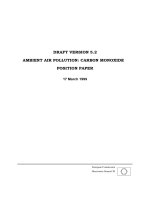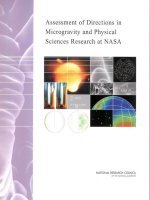- Trang chủ >>
- Khoa Học Tự Nhiên >>
- Vật lý
5 2 how matter changes (physical sciences)
Bạn đang xem bản rút gọn của tài liệu. Xem và tải ngay bản đầy đủ của tài liệu tại đây (4.45 MB, 12 trang )
Physical Sciences
Standards
Preview
1.f. Students know differences in
chemical and physical properties
of substances are used to separate
mixtures and identify compounds.
Standard Set 1. Physical Sciences
1. Elements and their combinations
account for all the varied types of
matter in the world. As a basis for
understanding this concept:
1.g. Students know properties of solid,
liquid, and gaseous substances, such
as sugar (C6H12O6), water (H2O), helium
(He), oxygen (O2), nitrogen (N2), and
carbon dioxide (CO2)
1.a. Students know that during
chemical reactions the atoms in the
reactants rearrange to form products
with different properties.
1.c. Students know metals have
properties in common, such as high
electrical and thermal conductivity.
Some metals, such as aluminum (Al),
iron (Fe), nickel (Ni), copper (Cu),
silver (Ag), and gold (Au), are pure
elements; others, such as steel and
brass, are composed of a combination
of elemental metals.
Genre
Nonfiction
Comprehension Skill
Draw Conclusions
Text Features
•
•
•
•
Captions
Charts
Labels
Glossary
Science Content
Changes in Matter
by Carmen Padilla
Scott Foresman Science 5.2
ISBN 0-328-23567-9
ì<(sk$m)=cdfghe< +^-Ä-U-Ä-U
Vocabulary
chemical change
chemical equation
condensation
evaporation
physical change
product
reactant
sublimation
by Carmen Padilla
Picture Credits
Every effort has been made to secure permission and provide appropriate credit for photographic material. The
publisher deeply regrets any omission and pledges to correct errors called to its attention in subsequent editions.
Unless otherwise acknowledged, all photographs are the copyright of Dorling Kindersley, a division of Pearson.
Photo locators denoted as follows: Top (T), Center (C), Bottom (B), Left (L), Right (R), Background (Bkgd).
Opener: ©Julian Calder/Corbis; 7 ©Runk/Schoenberger/Grant Heilman Photography; 11 (B) Photowood Inc./Alamy
Images; 12 Andrew Lambert Photography/Photo Researchers, Inc.; 14 Layne Kennedy/Corbis; 15 ©Julian Calder/Corbis;
18 (TR) ©Lars Klove/Getty Images.
ISBN: 0-328-23567-9
Copyright © Pearson Education, Inc. All Rights Reserved. Printed in the United States of America.
This publication is protected by Copyright, and permission should be obtained from the publisher prior to any
prohibited reproduction, storage in a retrieval system, or transmission in any form by any means, electronic,
mechanical, photocopying, recording, or likewise. For information regarding permission(s), write to
Permissions Department, Scott Foresman, 1900 East Lake Avenue, Glenview, Illinois 60025.
1 2 3 4 5 6 7 8 9 10 V010 13 12 11 10 09 08 07 06
How does matter
change?
Physical Changes
Matter changes all the time. A physical change takes place
when matter changes in size, shape, volume, or state.
For example, a block of ice melts to form a puddle. The ice
and puddle are different in size, shape, volume, and state. Yet
they are the same substance: water. A physical change has
taken place.
You can cause a physical change by cutting paper, grating
cheese, boiling water, even styling your hair. In each case, the
substance stays the same.
Chemical Changes
A chemical change takes place when one kind of matter
changes into a different kind of matter with different properties.
Chemical changes often take place when you prepare meals. For
example, cooked eggs have different chemical properties than
raw eggs. Similarly, eggs change to different substances as your
body digests them. One kind of matter changes into a different
kind of matter with different properties.
Chemical changes often produce heat, sound, or light. But
it isn’t always obvious when a chemical change has taken place.
Sometimes you have to look for clues. Iron is usually gray. When
it rusts, it has a reddish-orange color. This indicates a chemical
change. The rust has different properties than the iron.
Silver crystals formed on
the copper tree. Chemical
changes took place in the
liquid and on the copper.
This tree is made of copper
wire. Shaping the wire into
a tree caused a physical
change.
The copper tree is placed
in a liquid.
2
3
Liquids
States of Matter
If you leave a glass of lemonade outside on a hot sunny day,
you will soon have less lemonade. That’s because lemonade is
mostly water. The liquid water will evaporate, turning into a gas.
Solid, liquid, and gas are three forms of matter. An object’s
state of matter depends on the positions and motions of its
atoms or molecules. The position of these particles is different in
each phase of matter.
Solids
Solids have a definite shape and volume. Particles in solids
are usually very close together. Forces between the particles
keep them from moving from one place to another. Yet solid
particles are not absolutely still. They move in place, like a
person in a rocking chair.
Particles of air spread far
apart in this balloon.
Solid
4
Suppose you try to build a snowman indoors. The snow
melts into a liquid. You don’t have a snowman—you have a mess!
As a solid absorbs heat energy, it melts into a liquid. As
the solid warms, its particles no longer vibrate in place. They
begin to move and flow past one another. That’s why liquids
do not have a shape of their own. They take the shape of their
container. But liquids do have a definite volume. Forces between
liquid particles keep them close together, although not as close
as forces between solid particles.
Gases
Particles in gases are very far apart compared with particles
in solids or liquids. Gas particles can be squeezed much more
than solid or liquid particles. That’s because there is so much
more space between them.
Suppose that you blow up a balloon. Gas particles spread
out evenly throughout the balloon. The balloon is tight and
round. As the balloon loses air, it is less tight and starts to get
smaller. The remaining gas particles are still spread out evenly
throughout the balloon. But the shape and volume of the
balloon have changed. Like all gases, the air inside the balloon
has neither a definite shape nor a definite volume.
Liquid
Gas
5
Freezing and Melting
Particles on the Move
When the temperature is 0ºC, freshwater changes. It freezes
to become ice. Ice also changes state at 0ºC. Ice melts to become
water. Because 0ºC is the temperature at
which water freezes and melts, 0ºC is
both the freezing point and melting point
of water.
Each substance—water, sugar,
gold, and so on—has its own melting
temperature. This physical property of
matter is important. Chemists can use it
to help them identify a material. Engineers
can use it to help them choose the best
materials for automotive parts.
Substances have a wide range of melting
temperatures. For example, frozen oxygen has a
melting temperature of –218ºC. By comparison,
the melting temperature of iron is 1535ºC!
Particles move differently in a solid, a liquid, and a gas.
The speed with which particles move depends partly on the
temperature of a material. As temperature increases, particles
move faster. As temperature decreases, particles move more
slowly. When liquids get so cold that they freeze solid, their
particles slow down and vibrate in place.
The faster particles move, the greater the space between
the particles becomes. As the space between particles increases,
matter gets a little larger. It expands. Particles never get cold
enough to stop vibrating—even when a liquid freezes solid.
The freezing and melting
temperature is an important
property of a substance.
6
7
Condensation
Wet clothes on a line are
dried by evaporation.
Condensation is a process that occurs when a gas turns
into a liquid. You can see the results on a glass of ice water.
When air particles touch the cold surface of the glass, their
temperature falls. As they cool, the gas particles condense into
liquid droplets on the outside of the glass.
Clouds and dew are formed by condensation. So are things
like fog on a car windshield or on someone’s eyeglasses.
Sublimation
Evaporation
Evaporation takes place when particles leave a liquid and
become a gas. You’ve seen it happen if you have ever heated
water to make instant soup or cocoa.
Most evaporation takes place at the surface of a liquid.
This means that liquid particles change to gas at the surface.
Below the surface, the particles stay
liquid. If you heat water to the boiling
point, you’ll see the whole liquid full
of gas bubbles.
Each liquid has its own boiling
point. You can use this physical
property to help identify a liquid.
Bubbles rising to the top of
the liquid become a gas.
8
Sublimation occurs when a solid changes directly to a gas
without first becoming a liquid. The particles move so fast that
they escape, as a gas, from the surface of the solid. Only some
solids undergo sublimation. Ice is one that does.
When you leave an ice cube in your freezer for a long time,
the ice cube shrinks. Part of the ice cube changes into water
vapor. Sublimation has taken place.
A more dramatic example is dry
ice (solid carbon dioxide). If you
expose dry ice to the air, it will
change to vapor right before
your eyes. People who
design movie or theater
sets use dry ice to
create fog.
Dry ice can change
directly to vapor.
9
Chemical Reactions
There are many types of chemical reactions. Each type
produces a chemical change in matter. One substance changes
into a different substance with different properties.
The picture shows the chemical reaction that takes place
if you run electricity through water. Water is the reactant, the
substance used in the chemical reaction. Hydrogen and oxygen
are the products, the substances made by the reaction.
During the reaction, water undergoes a chemical change.
The atoms in the water molecules rearrange to form hydrogen
and oxygen gases.
A chemical equation is a sentence that uses symbols to
describe a chemical reaction. The chemical equation for the
reaction shown on page 10 is shown below.
Notice that the reactant, water, is listed on the left side of the
equation. The products, hydrogen and oxygen, are listed on the
right side. The arrow is like the equal sign in a math equation.
Chemical reactions begin and end with the same amount
of matter. They follow a law called the Law of Conservation
of Mass. According to that law, the total mass of the reactants
equals the total mass of the products.
2H2O
2H2
+
Test tubes collect
gas bubbles.
O2
+
Water
Reactant
Hydrogen
Products
Oxygen
Several chemical reactions
take place in fireworks as
they explode in the sky.
A battery
provides
the energy
for the
reaction.
10
11
Three Types of Reactions
Three types of reactions are decomposition reactions,
combination reactions, and replacement reactions. The
experiment on page 10 is a decomposition reaction. In this type of
reaction, compounds break apart to form smaller compounds
or elements. In the experiment, water breaks apart to form
hydrogen and oxygen gases.
In a combination reaction, elements or compounds are
combined. They come together to form new compounds. A
combination reaction takes place when magnesium and oxygen
join to form magnesium oxide. A combination reaction also
occurs when iron and sulfur combine to form iron sulfide.
In a replacement reaction, one or more compounds breaks
apart. The parts then switch places.
Silver nitrate is chemical used in the film for cameras.
Sodium chloride is just plain table salt. A replacement reaction
takes place when you combine the two chemicals. Both of these
chemicals are clear liquids in solution. When you mix them
together, they react to form silver chloride and sodium nitrate.
Silver chloride is a solid. It will turn the beaker cloudy and
eventually settle to the bottom.
Notice that the silver (Ag) and sodium (Na) switch places.
On the left side of the equation, silver comes first. On the right
side, sodium comes first.
Silver nitrate and sodium chloride
undergo a replacement reaction
when combined in solution. Solid
silver chloride forms.
O
N
Oxygen and magnesium join
in a combination reaction.
The product is magnesium
oxide. This product has
properties that differ from
those of the reactants.
12
O
O
+ Na
O
Ag
Silver Nitrate
Cl
Sodium Chloride
O
N
+ Ag
O
Cl
Silver Chloride
Na
Sodium Nitrate
13
A candle undergoes both
physical and chemical
changes as it burns.
Think about the combination reaction that forms carbon
dioxide. The green circle in the model represents carbon.
The purple circle represents oxygen. When these substances
combine, they form a new substance made up of both kinds of
circles. The new substance is carbon dioxide.
Look at the second row in the chart. It shows how atoms
rearranged in the decomposition reaction from page 10, where
electricity was run through water. Look at the third row to see
the replacement reaction that causes solid silver chloride to form
when you mix silver nitrate and sodium chloride in solution.
Remember that no atoms are lost or added in any type of
chemical reaction.The atoms simply combine in new ways to
form new substances.
Type of Reaction
More About Chemical Reactions
Remember that matter can change in two ways: physically
and chemically. Chemical changes take place during chemical
reactions. Atoms in the reactants rearrange to form products
that have different properties.
The chart on page 15 shows how atoms are rearranged
in the three types of chemical reactions you have read about.
Find the model of a combination reaction in the chart. It
shows what happens when pairs of reactants combine to form
a single product.
14
Model
Decomposition
Combination
Replacement
15
Using Chemical
Properties
Separating Mixtures
The substances in some
mixtures, like oil and vinegar, have
different physical properties. Those
substances can be easily separated
by physical means. Other mixtures
cannot easily be separated by physical
means. To separate them, a knowledge of
chemical properties is helpful.
Scientists use chemical properties to get fossils out of
limestone. Vinegar dissolves limestone but does not harm the
fossil itself.
Chemical properties are also used to make decaffeinated
coffee. Many adults like the taste of coffee but do not like to
have caffeine. So coffee manufacturers use chemicals to dissolve
the caffeine in coffee beans.
Separating Solutions
Chemical properties are also used to separate elements from
solutions. For example, scientists can use their knowledge about
lead to separate it from a solution of water and other materials.
Look at the picture. The solution being poured is made up
of water, lead, and other materials. The solution on the bottom
is made with iodine. When the two solutions mix, a reaction
takes place. The lead solution and the iodine solution combine
to form lead iodide. This yellow solid can be easily filtered out
of the liquid.
Lead solution
Separating Metals from Ores
Ores are rocks that include metals combined with other
substances. Copper ore contains copper. Iron ore contains iron.
An ore called bauxite contains aluminum. Chemical properties
are used to release metals from their ores. Iron is separated from
iron ore, copper is separated from copper ore, and bauxite is
changed to aluminum metal.
16
Lead iodide
Iodine solution
17
Identifying Things
Acids and bases are two types of substances with different
properties. Both acids and bases react with chemicals in special
paper called universal indicator paper. The chemical reactions
cause color changes in the paper. Strong acids will turn the
paper red. Weaker acids or bases will turn it different colors.
Acids and bases will turn some other kinds of papers and liquids
different colors too.
Scientists can use indicator paper to get clues about a
substance’s identity. But many different acids will turn indicator
paper red. Many bases will turn it purple. Scientists often need to
test further to tell exactly what a substance is.
Strontium
chloride
Acids
Bases
Household soap
Barium
chloride
Calcium
chloride
Potassium
chloride
Flame Tests
Scientists can use flame tests to help identify compounds like
those shown in the photograph. In a flame test, a wire is dipped
in a powder or solution of the substance to be tested. Then the
wire is held in a flame.
Different substances cause the flame to turn different colors.
The flames have to be studied with laboratory equipment to
identify the substances.
Vinegar
18
19
Glossary
What did you learn?
1. How are physical and chemical changes alike and different?
chemical change
chemical equation
condensation
a change in which one kind of matter
changes into a different kind of matter
with different properties
3. The chemical equation for the formation of rust from iron and
oxygen is: 2Fe + 3O2 ‡ Fe2O3. What type of reaction is it? How can
you tell?
a statement of chemical symbols that
shows what happens during a chemical
reaction
4.
the process by which particles leave a gas
and become a liquid
Write a paragraph about how scientists use
chemical properties to identify substances. Then read and revise it
to make it clearer. Include information from the book.
5.
Draw Conclusions How can people use physical and chemical
changes in matter in their daily lives?
evaporation
the process by which particles leave a
liquid and become a gas
physical change
a change in which matter keeps the same
chemical properties; a change in size,
shape, volume, or state of matter
product
a substance made by a chemical reaction
reactant
a substance used in a chemical reaction
sublimation
the process by which a solid changes
directly into a gas
20
2. What happens in solid particles as a solid melts into a liquid?









